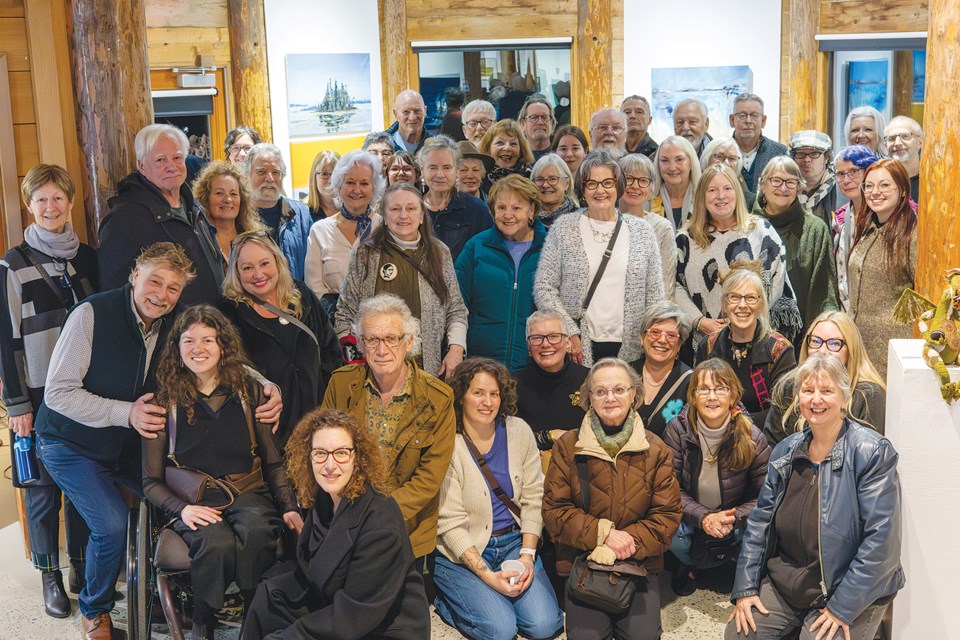Only two days after a frenzied surge of 60 last-minute contributions, the Sunshine Coast Arts Council’s annual Friends of the Gallery show launched on Jan. 10 with a crowded public reception at its Sechelt complex. A record-breaking total of 115 member artists each contributed a single work to the exhibition, which has been held each year for more than a quarter-century.
“It can be quite vulnerable to share your work in public,” said Keely Halward, the council’s assistant curator. Halward led a small team that identified harmonies among the works — themes, colour palettes, mediums — and grouped them accordingly. “For some people, it might be the first time they’ve shared their work,” Halward continued. “For others, they may be doing that in galleries all over North America. It’s just so stunning to have these works in relationship on these walls, from those who don’t know each other but who have shared something of themselves for the rest of us to enjoy.”
The volume of works overflows the high-ceilinged Doris Crowston Gallery on Medusa Street, extending down the facility’s kitchen corridor and into interior sanctums. In a log-walled chamber, three-dimensional installations offer an illusory sense of domesticity: Megan Dewar’s Inside/Outside? the Box combines broken ceramics, glass and a recycled television to present a sharp-cornered vision of pastel butterflies. A vintage upright microphone converted by Gord Birtch (Mic Light [Early 1960s Electrovoice 726]) projects concentric illuminations. On a low table next to a sofa are arrayed written and illustrated works by stego (a hand-lettered zine titled thrice that exhorts readers to “find pockets of sanctuary in the everyday”) and Jane Covernton’s post-apocalyptic photography collection After the End Times: Imagining the Future.
Depictions of skulls in two linocuts — The Seer, by denise allen, and Untitled, by Courtney Galloway — complement a stony winter landscape in oils by Laurie Franze (Mountain Views).
Halward and her hanging committee began by grouping works with similar hues, even if mediums and substrates differed dramatically. “You just have to pick a path,” she observed. Delicate sandbars appearing in a pensive oil by Jon Bell (The Islet) echo the amber sky of Sunset Shift, a photograph by Ann Stampfl portraying a tugboat in silhouette.
The colours re-appear in the constellations of Ochre Seastars, an occasional table fashioned from rescued wood by Cornelia VanBerkel. Mindy Hemstalk’s Feminine Curl — a ceramic octopus coiled atop a burled plinth of driftwood — glistens in daylight from an adjacent window. Nearby, the arresting gaze of Teresa Selbee’s Baker’s human subject (in her oil-on-wood Light Somewhere in the Distance) draws viewers to a pier’s converging lines and petal-tinted horizon. The unflinching eyes of David Kilpatrick’s acrylic Susaweca — in which a regally adorned Plains Indigenous woman cradles the head of a horse bearing dragonfly insignia — also seem to scrutinise any passers-by.
The exhibition provides a dazzling range of mediums which include textiles (Penny Stewart used mohair and novelty yarns to produce the intricate weaving Impression of the Fraser Valley; Marianne Hanson created her lifelike Snowshoe Hare out of merino wool and wire on wood) and inorganic elements (Betti Clipsham’s La Memoria de la Arena combines acrylic and sand to fashion an emotionally laden abstract evoking liminality).
A clay boot by Maureen Bryce (Oxblood Cowboy Boot) is filled with coral-coloured blossoms. Wendy Harford applied acrylic paint and fabric trim to a recycled fan in The Bee Keeper, forming a uniquely proportioned vision of nature (and its attendant spirits) in full flush, scattered with hexagonal apiary motifs.
Ceramicist Ray Niebergall reflected the exhibition’s tacit theme of sublimation in his complementary works Hope/Pain: two discs that alternately denote the tortuous passage of time and the possibility of escape or transcendence. “For me,” Niebergall explained, “hope is — a possibility — being part of a larger whole, a sense of belonging to something greater than oneself — a state of mind — an orientation of the heart — a conviction that things ultimately make sense.”
The Friends of the Gallery exhibition continues at the Sunshine Coast Arts Centre until Feb. 8.




